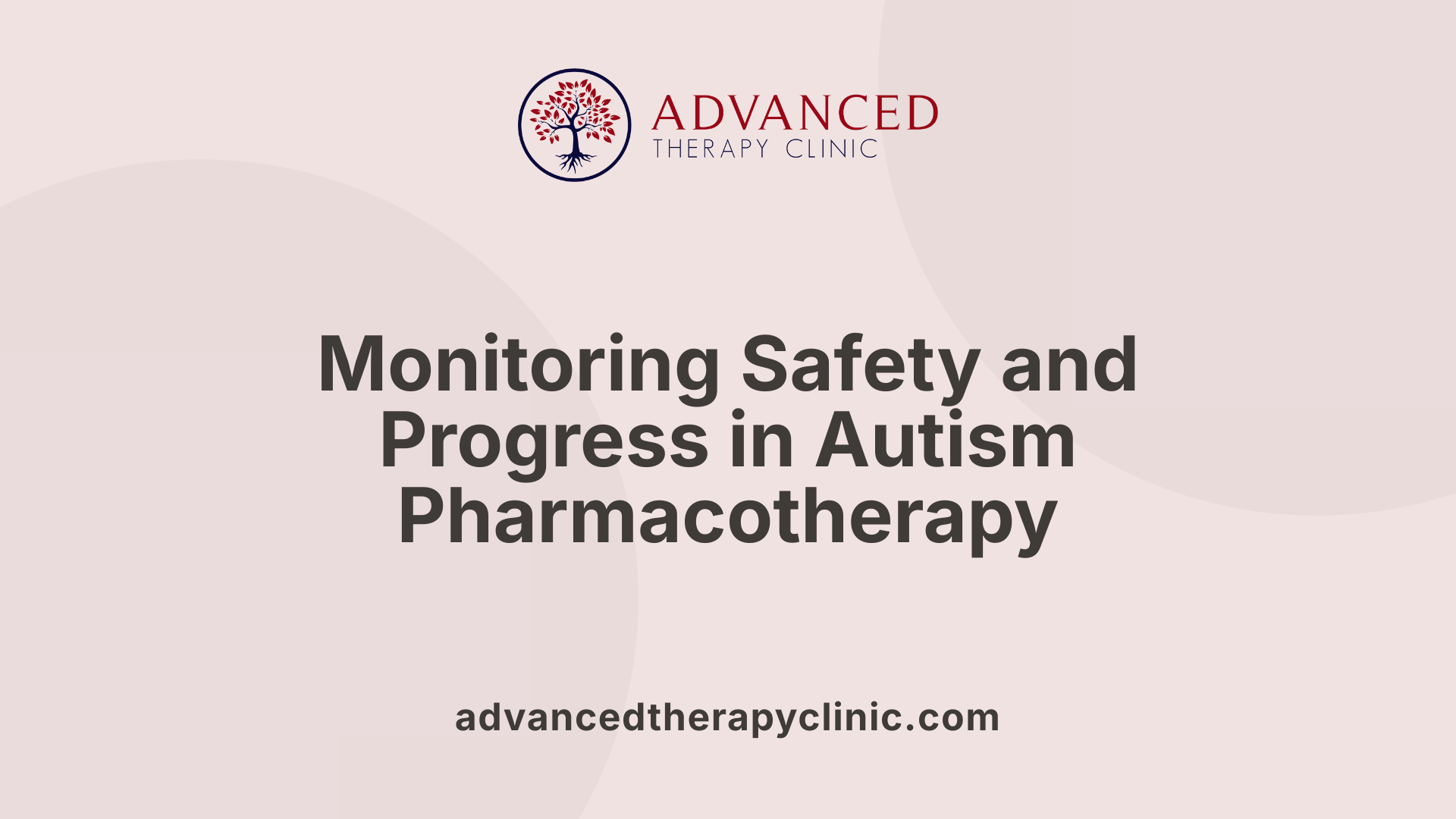Medication for Autism


Setting the Stage: Autism and Treatment Approaches
Autism Spectrum Disorder (ASD) is a complex neurodevelopmental condition characterized primarily by challenges in social communication and repetitive behaviors. While there is no medication to cure ASD or directly treat its core symptoms, a multitude of therapeutic interventions exist to improve quality of life and daily functioning. Among these, medication plays a supporting role, primarily targeting co-occurring symptoms and behaviors. This article explores the place of medication within the broader spectrum of autism therapies, highlighting its benefits, limitations, and integration with evidence-based behavioral and developmental treatments.
The Complexity of Autism and Its Treatment Landscape

What Are the Core Symptoms and Challenges of Autism Spectrum Disorder?
Autism Spectrum Disorder (ASD) primarily affects communication, social interaction, and behavior. Individuals with ASD often face challenges in understanding and using verbal and nonverbal communication, developing social skills, and managing repetitive or restrictive behaviors. Additionally, many experience co-occurring medical and mental health issues such as anxiety, sleep problems, epilepsy, and gastrointestinal difficulties, which further complicate care and treatment.
What Treatment Approaches Are Used Beyond Medication?
While there is no medication that directly treats the core symptoms of autism, varied therapeutic interventions form the foundation of effective treatment plans. Behavioral therapies, particularly Applied Behavior Analysis (ABA), remain the most evidence-based approaches to improving communication, social, and adaptive skills. ABA employs techniques such as discrete trial training and pivotal response training to encourage positive behaviors and reduce challenges.
Developmental therapies like speech-language therapy help improve functional communication, including alternative methods such as sign language or picture exchange communication systems. Occupational therapy addresses daily living skills, sensory integration, and motor coordination, while physical therapy focuses on gross and fine motor development. Social-relational methods, such as social skills training and DIR/Floor Time, foster emotional connections and peer interactions.
Psychological therapies, including cognitive-behavioral therapy (CBT), assist individuals in managing anxiety and depression. Families may also explore complementary therapies like melatonin for sleep disturbances or animal-assisted therapy, though evidence for many alternative treatments is limited and should be approached cautiously.
Why Are Individualized Treatment Plans Important?
ASD manifests differently in every person, which makes one-size-fits-all approaches ineffective. Treatment plans are tailored to the individual's age, abilities, challenges, and family context. Early interventions, ideally started before age three, leverage developmental plasticity for better long-term outcomes. These plans are dynamic and reviewed regularly to adapt goals as individuals grow and their needs evolve.
How Do Multidisciplinary Care Teams Support Treatment?
Effective management of autism involves a team of specialists including behavior analysts, speech-language pathologists, occupational and physical therapists, pediatricians, neurologists, psychologists, and educators. This multidisciplinary approach ensures comprehensive attention to all aspects of an individual's development, health, education, and family support. Coordination among these professionals promotes integrated care, maximizing the overall benefits for individuals with ASD.
Medications in Autism: What They Can and Can’t Do
No Medication Cures Autism or Treats Core Symptoms
Currently, there is no medication that can cure autism spectrum disorder (ASD) or directly treat its core symptoms such as social communication challenges and repetitive behaviors. Treatment efforts focus on managing associated symptoms rather than the condition itself.
Medications Target Co-occurring Symptoms Such as Irritability and Anxiety
Medications are commonly used to address co-occurring symptoms in individuals with ASD, including irritability, aggression, anxiety, hyperactivity, sleep disturbances, and seizures. These medications help improve overall functioning and quality of life.
FDA-Approved Medications: Risperidone and Aripiprazole for Irritability
The U.S. Food and Drug Administration (FDA) has approved two antipsychotic medications — risperidone and aripiprazole — specifically to treat irritability and behavioral issues in children with ASD. These drugs have demonstrated efficacy in reducing aggression, self-injury, and severe mood swings.
Off-label Use of Other Medications
Various other medications may be used off-label to treat symptoms associated with autism. These include selective serotonin reuptake inhibitors (SSRIs) for anxiety and repetitive behaviors, stimulants for hyperactivity, anti-anxiety drugs, tricyclic antidepressants, and anticonvulsants for seizure control. However, these are not FDA-approved specifically for ASD and require cautious use.
Importance of Healthcare Professional Monitoring
Because many medications can have side effects, ongoing monitoring by healthcare professionals is essential. This involves regular assessments of physical health including weight, blood pressure, and laboratory tests to track liver function and metabolic status. Careful supervision ensures medications remain safe and effective as part of a comprehensive treatment plan.
Managing Behavioral and Emotional Challenges with Medication
Use of Antipsychotic Medications to Manage Irritability, Aggression, Self-Injury
Antipsychotic drugs like risperidone and aripiprazole are FDA-approved for treating irritability in children with ASD. They are effective in reducing aggression, self-injury, and severe behavioral outbursts. These medications help enhance overall daily functioning and are often part of a broader treatment plan.
Stimulants for Hyperactivity and Focus
Stimulant medications can increase focus and reduce hyperactivity, particularly in individuals with milder forms of ASD. They are commonly used to manage symptoms similar to attention-deficit hyperactivity disorder (ADHD), supporting improved concentration and task completion.
SSRIs Reducing Repetitive Behaviors and Anxiety
Selective serotonin reuptake inhibitors (SSRIs) may help decrease repetitive behaviors and reduce anxiety, irritability, and tantrums associated with ASD. They also can improve eye contact and social engagement, contributing to better behavioral outcomes.
Tricyclic Antidepressants for Depression and Obsessive-Compulsive Symptoms
Tricyclic antidepressants are sometimes used to treat depression and obsessive-compulsive behaviors in individuals with ASD. These medications target underlying mood disturbances and help moderate compulsive actions that interfere with daily life.
Anti-Anxiety Medications for Anxiety and Panic Disorders
Anti-anxiety drugs assist in relieving anxiety and panic symptoms frequently experienced by people with autism. Managing these co-occurring conditions improves emotional regulation and enables better participation in therapies and social activities.
Medication management requires careful monitoring by healthcare professionals due to potential side effects and the need for dosage adjustments. Pharmacological treatments do not cure autism but significantly help in reducing behavioral and emotional challenges, complementing behavioral and developmental therapies.
Addressing Seizures and Sleep Disorders in Autism Through Medication
Epilepsy prevalence in autism and use of anticonvulsants
Seizures and seizure disorders affect nearly one-third of individuals with autism spectrum disorder (ASD). Managing epilepsy in people with ASD is crucial for improving overall health and daily functioning. Anticonvulsant medications are commonly prescribed to control seizures. These drugs help stabilize electrical activity in the brain, reducing the frequency and severity of seizures.
Sleep disturbances and melatonin treatment
Sleep problems, including difficulties falling asleep and maintaining sleep, are frequent among children and adults with ASD. Melatonin, a hormone that regulates the sleep-wake cycle, has been shown to be effective and safe for improving sleep disturbances in children with neurodevelopmental disabilities such as autism. Treatment with melatonin can help regulate sleep patterns, which in turn benefits daytime behavior and overall well-being.
Safety and monitoring considerations for these medications
While anticonvulsants and melatonin can offer significant benefits, they require careful medical oversight. Anticonvulsant therapy involves regular monitoring of blood levels, liver function, and other laboratory tests to ensure safety and detect side effects early. Similarly, melatonin treatment should be supervised by healthcare providers to optimize dosing and monitor for any adverse effects. Close collaboration between families and medical professionals ensures that medication plans are tailored to individual needs and adjusted over time for maximum benefit.
Complementary and Alternative Medicine: Supplement or Risk?
What Complementary and Alternative Therapies Are Commonly Used?
Many families of individuals with autism spectrum disorder (ASD) explore complementary and alternative medicine (CAM) therapies to supplement traditional treatments. Popular CAM approaches include special diets, various vitamins and supplements, animal-assisted therapies involving horses or dogs, mindfulness practices, and arts therapies such as music and art therapy. These methods often aim to enhance emotional expression, reduce anxiety, and improve daily functioning alongside conventional therapies.
Is There Strong Evidence Supporting These Methods?
Currently, evidence supporting CAM therapies remains limited or inconclusive. While some approaches, like melatonin for improving sleep disturbances, have demonstrated safety and effectiveness, most CAM treatments do not have robust scientific backing to confirm their benefits for ASD core symptoms. Due to this lack of solid evidence, CAM therapies are generally considered supplements rather than replacements for evidence-based interventions like behavioral therapy or speech and occupational therapies.
Are There Risks Associated With Unproven Treatments?
Certain alternative treatments, such as chelation therapy and cannabidiol (CBD) oil, carry potential risks and are not supported by scientific evidence for treating autism. Some can be harmful, leading to serious health complications. Families should exercise caution and be aware of the dangers associated with unproven remedies, especially those involving invasive procedures or unregulated supplements.
Why Is Consulting Healthcare Providers Important?
Consulting qualified healthcare professionals before starting any CAM therapy is crucial. Providers can help assess safety, identify possible interactions with other treatments, and recommend appropriate, evidence-informed options. Collaboration with healthcare teams ensures that complementary therapies can be integrated thoughtfully and safely into the overall care plan for individuals with ASD.
Behavioral and Developmental Therapies: The Foundation of Autism Treatment
What is Applied Behavior Analysis (ABA), and how does it work?
Applied Behavior Analysis (ABA) is a widely practiced behavioral therapy that forms the cornerstone of autism treatment. It uses principles of behavioral psychology to encourage positive behaviors and reduce challenging ones. Techniques such as Discrete Trial Training (DTT) and Pivotal Response Training (PRT) are common methods within ABA. DTT breaks skills into small, manageable steps reinforced with prompts and rewards, while PRT focuses on enhancing motivation and natural communication. ABA replaces punishment with positive reinforcement to shape behavior over time.
What role do speech-language therapy and occupational therapy play?
Speech-language therapy supports children in developing meaningful communication skills. This includes improving vocabulary, pronunciation, ability to make requests, and understanding nonverbal cues. Therapists also work with alternative communication methods such as sign language or picture exchange systems for nonverbal children.
Occupational therapy helps individuals gain independence in daily living activities like dressing, eating, and writing. It also addresses sensory integration challenges common in autism, helping regulate responses to sensory input. This therapy is customized to individual needs and plays a crucial role in enhancing autonomy.
How do physical therapy and social skills training support individuals with autism?
Physical therapy works to improve gross and fine motor skills, balance, posture, coordination, and overall movement ability. Early integration of physical therapy can boost functional mobility.
Social skills training is vital, especially for adolescents and young adults. It teaches skills for peer interaction, understanding social cues, and managing situations like bullying. These sessions often occur in groups to foster real-world social engagement.
Why is early intervention important?
Starting therapies before age 3 leverages developmental plasticity, leading to greater long-term benefits. Early treatment supports foundational learning, communication, and behavioral skills. However, therapies remain beneficial at any age and should be tailored to individual needs as children grow and develop.
How do medications complement behavioral and developmental therapies?
While there is no medication that cures or directly treats the core symptoms of autism, medications can manage co-occurring conditions like anxiety, irritability, sleep disorders, and hyperactivity. Drugs such as risperidone and aripiprazole are FDA-approved to reduce irritability and aggression in children with ASD. Medications are used alongside behavioral and developmental therapies to optimize overall progress and quality of life, not as standalone treatments.
| Therapy Type | Focus Area | Key Techniques/Methods |
|---|---|---|
| ABA | Behavior modification | DTT, PRT, positive reinforcement |
| Speech-Language Therapy | Communication skills development | Speech exercises, AAC devices, sign language |
| Occupational Therapy | Daily living skills and sensory integration | Self-care training, sensory processing activities |
| Physical Therapy | Motor skills and coordination | Balance training, gross/fine motor improvement |
| Social Skills Training | Peer interaction and emotional regulation | Social stories, group sessions, managing social cues |
| Medication | Manage co-occurring symptoms | Antipsychotics, SSRIs, stimulants, sleep aids |
Parental and Caregiver Support in Medication and Therapy Management
Parent Training Programs and Education
Parent training programs play a vital role in supporting families of children with autism spectrum disorder (ASD). These programs educate caregivers on strategies to promote communication, engagement, and social interactions tailored to their child's needs. By learning techniques used in therapies such as Applied Behavior Analysis (ABA), parents become empowered to reinforce positive behaviors and respond effectively to challenging signs.
Importance of Caregiver Involvement in Therapy Adherence and Behavior Monitoring
Caregiver involvement is essential for consistently applying therapeutic strategies across different environments, which strengthens skill development. Parents and caregivers actively monitoring behaviors can help identify progress and areas needing adjustment. Their engagement ensures that therapy goals are meaningful and aligned with daily routines, enhancing outcomes and providing real-time feedback to professionals.
Coordinating with Medical and Therapeutic Professionals
Effective management includes collaboration with a multidisciplinary team—behaviorists, therapists, pediatricians, and neurologists. Caregivers serve as important advocates, communicating observations and concerns to medical providers overseeing medications and monitoring for side effects. Regular consultations allow treatment plans, including medication regimens, to be adapted as the child's needs evolve.
Managing Evolving Needs as the Child Develops
Children with ASD experience changing developmental stages, with new challenges emerging during puberty and adolescence. Caregivers must track these transitions and adjust support accordingly, seeking updated therapeutic approaches or additional services like social skills groups. Proactive planning for independence and future supports enables better long-term adjustment and quality of life.
Parental and caregiver education and coordination enhance adherence to therapies and medications, forming a cornerstone of successful, individualized ASD treatment.
Monitoring and Safety Considerations in Pharmacotherapy for Autism
Why is regular health monitoring important during pharmacotherapy for autism?
Children with autism spectrum disorder (ASD) who take medications require routine health monitoring to ensure safety and effectiveness. This monitoring typically includes tracking weight, height, and blood pressure to detect any physical changes that might indicate adverse effects. Additionally, regular blood tests are essential to assess lipid profiles, liver function, and blood sugar levels, as many psychotropic medications can affect these parameters.
How are side effects managed in medication use for ASD?
Managing side effects is a critical aspect of pharmacotherapy. Health professionals closely observe any changes in behavior, mood, or physical health to identify potential medication-related problems early. Adjustments in dosage or switching medications may be necessary to minimize negative effects. Open communication between caregivers and the medical team helps in promptly addressing side effects and ensuring the individual's well-being.
What challenges are involved in long-term use of medications and dose adjustments?
Long-term medication use poses challenges such as the potential for developing tolerance, side effects accumulating over time, and variations in therapeutic response. Ongoing evaluation helps determine the need for dose adjustments, discontinuation, or introduction of new treatments. This careful balance aims to maximize benefits while minimizing risks, particularly as children grow and their needs evolve.
How does a collaborative approach benefit pharmacological treatment?
Effective pharmacotherapy for ASD involves a multidisciplinary team, including pediatricians, neurologists, and psychiatrists, working together. This collaboration ensures comprehensive care, combining expertise to tailor medication plans appropriately. Regular reviews by specialists allow for coordinated monitoring and timely modifications, supporting the overall treatment plan and improving outcomes for the individual.
Looking Ahead: Personalized Treatment Plans and Future Directions
Tailored Treatment Strategies Based on Individual Needs and Age
Treatment plans for autism spectrum disorder (ASD) are increasingly personalized, considering each individual's unique strengths, challenges, and developmental stage. Early intervention, especially before age 3, yields the most significant benefits by leveraging developmental plasticity. However, therapies remain beneficial across all ages, adapting as needs evolve. This personalized approach encompasses behavioral therapies like applied behavior analysis (ABA), speech and occupational therapies, physical therapy, and social skills training, ensuring targeted support.
Integration of Medication with Behavioral, Educational, and Developmental Therapies
Though no medication currently cures ASD or its core symptoms, integrating pharmacological treatments with developmental and educational therapies enhances overall support. Medications such as risperidone and aripiprazole, approved for managing irritability and aggression, can facilitate participation in behavioral interventions. Other drugs address co-occurring symptoms like anxiety, hyperactivity, and sleep disturbances. Careful monitoring and collaboration among healthcare providers ensure optimal medication use alongside therapies like speech-language and occupational therapy.
Advancements in Research and Evolving Understanding of Autism
Research continues to deepen understanding of autism’s diverse presentations and underlying biology, fostering the development of novel and refined therapies. Emerging behavioral interventions emphasize motivational and naturalistic techniques, such as Pivotal Response Training and Early Start Denver Model, making therapy engaging and family-inclusive. Additionally, growing evidence supports the cautious use of complementary approaches like melatonin for sleep, emphasizing the need for professional guidance.
Emphasis on Early Diagnosis and Ongoing Reassessment
Early diagnosis remains critically important to initiate prompt, evidence-based interventions that shape positive developmental trajectories. Specialists rely on behavioral observations paired with genetic testing when appropriate. Treatment plans are dynamic, requiring regular reassessment to address changing skills, challenges, and life stages. Multidisciplinary care teams play a vital role in adapting therapies and supports, promoting independence and quality of life across the individual’s lifespan.
Balancing Medication with Holistic Autism Care
Medication serves as a valuable tool in managing specific symptoms associated with autism spectrum disorder, particularly in addressing irritability, anxiety, hyperactivity, seizures, and sleep disturbances. However, it does not replace the essential behavioral, developmental, and educational therapies that form the cornerstone of autism treatment. A multidisciplinary and personalized approach, involving healthcare providers, therapists, individuals with autism, and their families, ensures optimal care. Early intervention, continuous monitoring, and informed decision-making about medications and complementary therapies contribute to improving outcomes and quality of life for individuals on the spectrum.
References
- Treatment and Intervention for Autism Spectrum Disorder
- Medication Treatment for Autism
- Autism Therapy Types & Interventions
- Autism spectrum disorder - Diagnosis and treatment
- What are the treatments for autism?
- Interventions and Services for Children with Autism Spectrum ...
- Autism Treatment Information
- Considerations for Prescribing /Recommending Common ...
Recent articles

Expressive Speech Delay 2-Year-Old
Understanding and Addressing Expressive Speech Delay in Toddlers

How Speech Recognition Works
Unlocking the Power of Speech Recognition in Therapy and Healthcare

Autism and Head Size
Understanding the Complex Relationship Between Autism and Head Size

Occupational Therapy in Autism
Enhancing Independence and Quality of Life Through Occupational Therapy in Autism

Do Autistic People Understand Sarcasm?
Navigating the Nuances: Understanding Sarcasm and Social Communication in Autism

Autism Routines
Crafting Effective Daily Structures for Children with Autism


